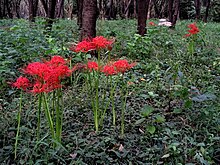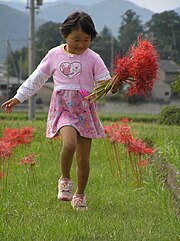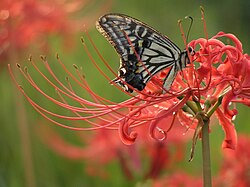| Revision as of 16:56, 8 September 2015 edit2602:306:8359:f080:251e:acf0:1fb8:5764 (talk) →Cultural references← Previous edit | Revision as of 04:29, 11 November 2015 edit undoSro23 (talk | contribs)Autopatrolled, Administrators53,146 editsNo edit summaryNext edit → | ||
| Line 40: | Line 40: | ||
| ==Cultural references== | ==Cultural references== | ||
| {{unreferenced section|date=October 2013}} | {{unreferenced section|date=October 2013}} | ||
| * The red spider lily is featured in the ] ] by ], which evokes the legend of the lily's blossoms and leaves never meeting. | * The red spider lily is featured in the ] '']'' by ], which evokes the legend of the lily's blossoms and leaves never meeting. | ||
| * It was also featured in the anime ''],'' surrounding the Ikari household when Misae confronts Lil' Slugger in episode 11. | * It was also featured in the anime ''],'' surrounding the Ikari household when Misae confronts Lil' Slugger in episode 11. | ||
| * It was also featured in the anime '']'' (Hell Girl), surrounding Enma Ai's house. | * It was also featured in the anime '']'' (Hell Girl), surrounding Enma Ai's house. | ||
| * It was also featured in the anime ''],'' during Kaneki's acceptance of his ghoul part. | * It was also featured in the anime ''],'' during Kaneki's acceptance of his ghoul part. | ||
| * It was also featured in the anime ''],'' in which Vincent Phantomhive compared Angelina Dalles' hair to the flower.(Later, in 2014, a musical appropriately named Lycoris That Blazes the Earth, was released) | * It was also featured in the anime ''],'' in which Vincent Phantomhive compared Angelina Dalles' hair to the flower.(Later, in 2014, a musical appropriately named Lycoris That Blazes the Earth, was released) | ||
| * It was also featured in the game ], when the player's character meets Wally for the last time on Victory Road. In addition, the character Zinnia's name in Japan is Higana, which comes from ''higanbana,'' the Japanese name for red spider lilies. | * It was also featured in the game ''],'' when the player's character meets Wally for the last time on Victory Road. In addition, the character Zinnia's name in Japan is Higana, which comes from ''higanbana,'' the Japanese name for red spider lilies. | ||
| * It was also featured in the third movie installment of the anime ''],'' when Homura discovers that she is no longer a magical girl and has become a witch. The flowers sprout again from the head of Homura's witch form where it has been cut off. | * It was also featured in the third movie installment of the anime ''],'' when Homura discovers that she is no longer a magical girl and has become a witch. The flowers sprout again from the head of Homura's witch form where it has been cut off. | ||
| * It was also featured in the manga ], when Higan is mentioned by Lilac. | * It was also featured in the manga ''],'' when Higan is mentioned by Lilac. | ||
| * It was also featured in the video game ], during the encounter with Oichi. | * It was also featured in the video game ''],'' during the encounter with Oichi. | ||
| * It was also featured in the manga ], used by Raikō Shimizu who leaves them on the corpses of people he kills. | * It was also featured in the manga ''],'' used by Raikō Shimizu who leaves them on the corpses of people he kills. | ||
| * It |
* It was also featured in the anime ''],'' during the opening. | ||
| * It was also featured in the "My Will" ending theme of the anime series,''].'' | |||
| * It is also featured in the "My Will" Ending of the Anime Series of Inuyasha, it's shown at the very beginning...then later around the time of showing a yin/yang symbol over them near/around the middle of the song...and then once more when the character Kikyo is seen breaking the flower at the stem (thus killing the flower) towards the end of the song the last it's seen, her act of breaking the flower can be seen as symbolism to both the meaning of the flower and her existence at that time in the series due to her returning from the dead (showing she is defying the natural order of death by returning) and what she deems throughout the series as her eventual fate as well. | |||
| ==References== | ==References== | ||
Revision as of 04:29, 11 November 2015
| Red magic lily 曼珠沙華 | |
|---|---|

| |
| Lycoris radiata | |
| Scientific classification | |
| Kingdom: | Plantae |
| Clade: | Tracheophytes |
| Clade: | Angiosperms |
| Clade: | Monocots |
| Order: | Asparagales |
| Family: | Amaryllidaceae |
| Subfamily: | Amaryllidoideae |
| Genus: | Lycoris |
| Species: | L. radiata |
| Binomial name | |
| Lycoris radiata (L'Hér.) Herb. | |
| Synonyms | |
| |
Lycoris radiata (red spider lily, red magic lily) is a plant in the amaryllis family, Amaryllidaceae, subfamily Amaryllidoideae. Originally from China, Korea and Nepal, it was introduced into Japan and from there to the United States and elsewhere. It is considered naturalized in Seychelles and in the Ryukyu Islands. It flowers in the late summer or autumn, often in response to heavy rainfall. The common name hurricane lily refers to this characteristic, as do other common names, such as resurrection lily; these may be used for the genus as a whole.
Description

Lycoris radiata is a bulbous perennial. It normally flowers before the leaves fully appear, on stems 30–70 centimetres (12–28 in) tall. The leaves are parallel-sided, 0.5–1 centimetre (0.20–0.39 in) wide with a paler central stripe. The red flowers are arranged in umbels. Individual flowers are irregular, with narrow segments which curve backwards, and long projecting stamens.
Taxonomy
The presumed original form of Lycoris radiata, known as L. radiata var. pumila, occurs only in China. It is a diploid, with 11 pairs of chromosomes (2N = 22), and is able to reproduce by seed. Triploid forms, with 33 chromosomes, are known as L. radiata var. radiata. These are widespread in China and also in Japan, from where the species was introduced into cultivation in America and elsewhere. The triploid forms are sterile, and reproduce only vegetatively, via bulbs. The Japanese triploids are genetically uniform. It has been suggested that they were introduced into Japan from China along with rice cultivation.
In phylogenetic analyses based on chloroplast genes, Hori et al. found that all the other species of Lycoris they examined were nested within Lycoris radiata. They suggest that the "species" of Lycoris presently recognized may not be distinct.
Cultivation
The plant was first introduced into the United States in 1854 when Japanese ports were opened for US trade. Captain William Roberts, who enjoyed botany, brought back only three bulbs of the red spider lily. The bulbs were then planted by his niece who found that they do not bloom until after the first good rain in the fall season. Plants have since become naturalized in North Carolina, Texas, and many other southern states of the US. Since the Japanese forms are sterile triploids, the introduced plants were also sterile and reproduce only by bulb division.
Lycoris radiata is not frost-hardy and so can only be grown under glass or in a very sheltered position in countries like England which are subject to frost. Bulbs can be stored in a dry environment between 45–55 degrees Fahrenheit (7–13 degrees Celsius). They should be planted in the spring in full sun in well-drained soil (e.g. sandy with some clay), 8 inches (20 cm) deep, with 6–12 inches (15–30 cm) between each bulb, and left undisturbed. Plants will flower in late summer or early fall, with stems around 24–28 inches (60–70 cm) tall. Leaves follow the flowers, remaining through the winter and disappearing in early summer.
Uses
The bulbs of Lycoris radiata are very poisonous. These are mostly used in Japan, and they are used to surround their paddies and houses to keep the pest and mice away. That is why most of them grow close to rivers now. In Japan the Red Spider Lily signals the arrival of fall. Many Buddhist will use it to celebrate the arrival of fall with a ceremony at the tomb of one of their ancestors. They plant them on graves because it shows a tribute to the dead. People believe that since the Red Spider Lily is mostly associated with death that one should never give a bouquet of these flowers.
Legends
| This section does not cite any sources. Please help improve this section by adding citations to reliable sources. Unsourced material may be challenged and removed. (October 2013) (Learn how and when to remove this message) |

Since these scarlet flowers usually bloom near cemeteries around the autumnal equinox, they are described in Chinese and Japanese translations of the Lotus Sutra as ominous flowers that grow in Diyu (also known as Hell), or Huángquán (Simplified Chinese: 黄泉; Traditional Chinese: 黃泉), and guide the dead into the next reincarnation.
Some legends have it that when you see someone that you may never meet again, these flowers, also called red spider lilies or corpse flowers, would bloom along the path. Perhaps because of these sorrowful legends, Japanese people often used these flowers in funerals. The popular Japanese name Higanbana (彼岸花, Higan bana) for Lycoris radiata literally means higan (the other or that shore of Sanzu River) flower, decorate and enjoyable, flower of afterlife in gokuraku jyōdo (極楽浄土, gokuraku jyōdo).
Cultural references
| This section does not cite any sources. Please help improve this section by adding citations to reliable sources. Unsourced material may be challenged and removed. (October 2013) (Learn how and when to remove this message) |
- The red spider lily is featured in the manhwa Bride of the Water God by Yun Mi-kyung, which evokes the legend of the lily's blossoms and leaves never meeting.
- It was also featured in the anime Paranoia Agent, surrounding the Ikari household when Misae confronts Lil' Slugger in episode 11.
- It was also featured in the anime Jigoku Shoujo (Hell Girl), surrounding Enma Ai's house.
- It was also featured in the anime Tokyo Ghoul, during Kaneki's acceptance of his ghoul part.
- It was also featured in the anime Kuroshitsuji, in which Vincent Phantomhive compared Angelina Dalles' hair to the flower.(Later, in 2014, a musical appropriately named Lycoris That Blazes the Earth, was released)
- It was also featured in the game Pokémon Omega Ruby and Alpha Sapphire, when the player's character meets Wally for the last time on Victory Road. In addition, the character Zinnia's name in Japan is Higana, which comes from higanbana, the Japanese name for red spider lilies.
- It was also featured in the third movie installment of the anime Puella Magi Madoka Magica, when Homura discovers that she is no longer a magical girl and has become a witch. The flowers sprout again from the head of Homura's witch form where it has been cut off.
- It was also featured in the manga Servamp, when Higan is mentioned by Lilac.
- It was also featured in the video game Sengoku Basara 3, during the encounter with Oichi.
- It was also featured in the manga Nabari no Ou, used by Raikō Shimizu who leaves them on the corpses of people he kills.
- It was also featured in the anime Ranpo Kitan: Game of Laplace, during the opening.
- It was also featured in the "My Will" ending theme of the anime series,Inuyasha.
References
- The Plant List
- Stevens, P.F., Angiosperm Phylogeny Website: Asparagales: Amaryllidoideae
- Kew World Checklist of Selected Plant Families
- Knox, Gary W. (2011), Hurricane Lilies, Lycoris Species, in Florida, Environmental Horticulture Department, Florida Cooperative Extension Service, Institute of Food and Agricultural Sciences, University of Florida, retrieved 2012-04-12
- ^ Mathew, Brian (1978), The Larger Bulbs, London: B.T. Batsford (in association with the Royal Horticultural Society), ISBN 978-0-7134-1246-8
- William Herbert. 1819. Botanical Magazine 47: pl. 2113
- L'Héritier de Brutelle, Charles Louis. 1788, Sertum Anglicum 16, as Amaryllis radiata
- ^ Hori, TA; Hayashi, A; Sasanuma, T; Kurita, S (2006), "Genetic variations in the chloroplast genome and phylogenetic clustering of Lycoris species", Genes Genet. Syst., 81 (4): 243–253, doi:10.1266/ggs.81.243, PMID 17038796
{{citation}}: Unknown parameter|lastauthoramp=ignored (|name-list-style=suggested) (help) - ^ Red Spider Lily, The Southern Bulb Company, archived from the original on 2011-09-13, retrieved 2011-09-13
- ^ Chandler, Brian (1999–2002), Higabana – red spider lily, archived from the original on 2011-09-13, retrieved 2011-09-13
- Evans, Erv; De Hertough, A.A., Lycoris radiata; Spider lily, Naked lily, Red spider lily, NC State University, archived from the original on 2011-09-13, retrieved 2011-09-13
{{citation}}: Unknown parameter|lastauthoramp=ignored (|name-list-style=suggested) (help) - ^ Klingaman, Gerald (2000), Plant of the Week : Red Spiderlily, University of Arkansas Division of Agriculture, Cooperative Extension Services, archived from the original on 2011-09-13, retrieved 2011-09-13
External links
- "Lycoris radiata." Backyard Gardeners. 2008. Backyard Gardeners. 13 Apr 2009 <http://www.backyardgardener.com/plantname/pda_deae.html>.
- "Lycoris radiata Herbert." Natural Resource Conservation Service. 13 Apr 2009. USDA. 13 Apr 2009 <http://plants.usda.gov/java/profile?symbol=LYRA>.
- Red Spider Lily Photo Gallery
- How to plant and care for the Red Spider Lily
- Where you can buy Red Spider Lily Bulbs
- How to know if you have Red Spider Lily poisoning